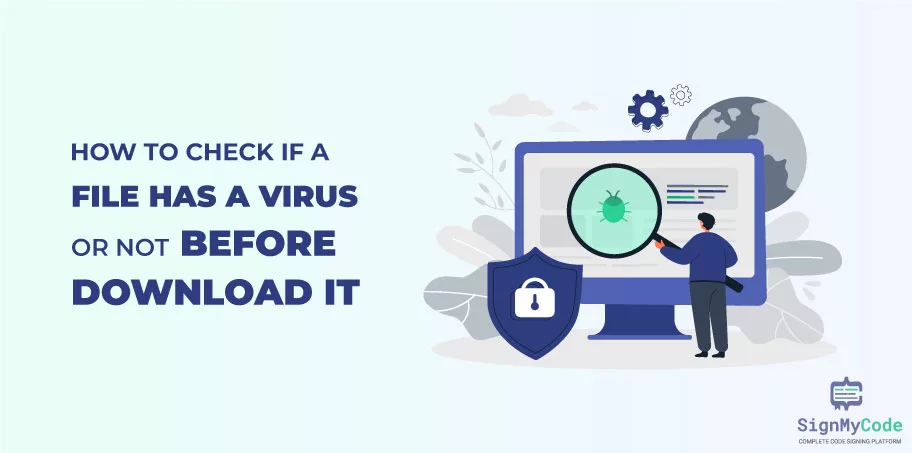How to Check If a File Has a Virus or not Before Downloading It?

The file has a virus or not! Though it is a four worded sentence, it is sure to scare you off. This concern is real as there is no scarcity of malware or viruses lurking in all corners of the world. Given the challenging technological scenario, detecting legitimate download sites is getting tougher every day. Fortunately, cybersecurity experts are saving us. Thus, detecting a virus corrupted file has become a convenient process.
Malware is short for ‘malicious software’ and refers to software that is designed to infiltrate or damage computer systems without the user’s knowledge or consent. Malware can take many forms, including viruses, worms, Trojans, ransomware, and spyware.
Some common types of malware are:
Viruses:
A virus is a type of malware that is designed to replicate itself and spread from one computer to another. Viruses can infect a system by attaching themselves to legitimate files or programs and can cause a variety of problems, such as deleting or corrupting files, stealing sensitive information, or using the infected computer to perform attacks on other systems.
Worms:
A worm is a type of malware that is designed to replicate itself and spread through networks, often without the user’s knowledge or consent. Worms can exploit vulnerabilities in computer systems to gain access and propagate themselves, and they can cause a variety of problems, such as consuming bandwidth and system resources, disrupting network traffic, and spreading other types of malware.
Trojans:
A Trojan is a type of malware that is disguised as legitimate software or other types of files. When a Trojan is run, it can perform malicious activities, such as downloading and installing additional malware, stealing sensitive information, or giving attackers access to the infected system.
These are some of the malware types that can seriously damage your system or, worse, steal your confidential data!
This is the reason why software developers digitally sign software code with EV Code Signing Certificates, as it assures the end-users that the software is safe and secure to use. However, before we talk about the digital signature, let us give you a clear overview of the virus-infected file!
What is a Virus-Infected File?
A virus file from the internet is a file that contains a virus, which is a type of malicious software that is designed to replicate and spread from one computer to another. Virus files can be spread through email attachments, downloaded from websites, or shared through file-sharing networks.
When a virus file is downloaded and run on a computer, the virus can infect the system and begin to replicate itself. Depending on the type of virus, it may perform various malicious activities, such as deleting or corrupting files, stealing sensitive information, or using the infected computer to attack other systems.
It is important to be careful when downloading files from the internet, as virus files can be disguised as legitimate software or other types of files. To protect against virus infections, it is recommended to use antivirus software and to be cautious when downloading files from unfamiliar sources.
It is also a good idea to scan any downloaded files with antivirus software before running or opening them.
There is no surefire way to know if a file you download has a virus, but there are a few ways that you can implement to determine if the file has any kind of malicious component. Let’s find that out.
What are the Best Ways to Detect Viruses in a Downloadable File?
Do you know what the best defense against malicious files you download from the Internet is? It is YOU! For basic online security practices, there is no replacement.
Securing your online activity is the key to staying away from phishing, adware, and ransomware threats. Let’s see how to detect viruses in a downloadable file.
Scan a Link For Malware Using VirusTotal
VirusTotal is a website that analyzes files and URLs for viruses, worms, Trojans, and other types of malware. It is a free service owned by Google and used by individuals and organizations worldwide to scan files and links for threats. Here is how to scan a link for malware using VirusTotal:
Step-1: Go to the VirusTotal website (https://www.virustotal.com).
Step-2: In the ‘URL‘ field, enter the link that you want to scan.
Step-3: Click on the ‘Scan it!‘ button.
Step-4: Wait for the scan to complete. This may take a few minutes, depending on the size of the link and the workload of VirusTotal’s servers.
Review the results of the scan. If the link is found to be malicious, the scan results will indicate the types of threats that have been detected. It can be a useful tool for checking links for malware and other threats before accessing them.
Check the Hash
Checking the hash of a downloaded file is a way to verify the integrity and authenticity of the file. A hash is a unique numerical value calculated based on a file’s contents. If the contents of the file change, even by a single bit, the hash value will be different.
To check the hash of a downloaded file, you will need to use a hash calculator tool. Many such tools are available online, both as standalone programs and as online services.
Here is a general process for checking the hash of a downloaded file:
Step-1: Download and install a hash calculator tool or an online service.
Step-2: Select the file that you want to check.
Step-3: Select the hash algorithm that you want to use. Best hashing algorithms include MD5, SHA- 1, and SHA-256.
Step-4: Click on the ‘Calculate’ or ‘Compute’ buttons to calculate the file hash.
Step-5: Compare the calculated hash value to the expected hash value for the file. If the values match, the file is likely to be authentic and unmodified. If the values do not match, it could be an indication that the file has been tampered with or is corrupt.
By checking the hash of a downloaded file, you can verify the integrity of the file and ensure that it is authentic and unmodified. This can be especially important when downloading critical or sensitive files, such as software updates or security patches. Usually, for checking the hash of a downloaded file, code signing certificates are used.
These are the ways that you can implement to detect viruses on a suspected file. The next step is to avoid downloading viruses from files off the Internet.
What are the Best Ways of Avoiding Virus Corrupted Files?
Nothing is perfect, not even software. So while using ViruTotal and checking the hash of a file is important, there is no guarantee that you are completely safe and can download the file. So what do you do then? Let us help you!
Avoid Visiting Untrusted Websites
It is always advised to stay away from websites that are untrusted, no matter how good and professional they look. They might pose security risks, reputation risks, privacy risks, and legal risks.
By avoiding untrusted websites, you can protect your device, personal information, and reputation and minimize the risk of exposure to security, privacy, and legal risks. It is encouraged to use top-level domain (TLD) websites such as .com, .net, .org, and .eu.
Only Download Files From Official Sources
Oftentimes, people find free files from a third-party website and fall prey to it. This is why it is important to download files from official sources because doing so can help protect against security and privacy risks. It is due to these reasons:
Security: Official sources are more likely to offer files that are safe and free of viruses, malware and software security threats.
Privacy: Official sources are more likely to respect your privacy and protect your personal information.
Legal: Downloading files from official sources can help to ensure that you are not engaging in illegal activities, such as downloading copyrighted material or pirated software.
Refrain from Sharing Data With or Download Files From Insecure Websites
The ‘s’ in ‘https’ stands for ‘secure,’ and it indicates that the website is using a secure, encrypted connection to transfer data. When you access a website that uses https, your connection to the website is encrypted, which means that any information you enter or that is transmitted between your device and the website is protected against interception by third parties.
It is generally recommended to use websites that use https, especially for sensitive activities such as online banking, shopping, or accessing personal information. By using https websites, you can help to protect your privacy and keep your information secure.
These are some of the best ways to combat the threat of downloading virus corrupted files.
Stay Alert, Stay Virus-Free!
It is important to know how to check if a file has a virus before downloading it because downloading and running a virus file can cause serious problems on your computer.
A virus can infect your system and replicate itself, potentially causing damage to your files, stealing sensitive information, or using your computer to perform attacks on other systems.
Additionally, viruses can often be disguised as legitimate software or other types of files, making it difficult to identify them just by looking at the filename or extension.
By knowing how to check if a file has a virus before downloading it, you can help to protect your system from infection and avoid the potential consequences of running a virus file.
“Protect your Code, Software and Application from Hacks, Thefts and Malwares!
Get Trusted and Robust Code Signing Certs at Lowest Price!

